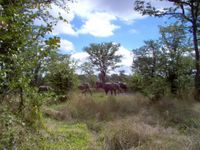Wednesday, 26 April. Sorted our reservations for camping in the Moremi reserve and then drove to the park entrance, initially on a good tarred road and then gravel and then the last part on a sand road. We decided to take our time and follow the track to the campsite at the Third bridge. This is about 60 km from the entrance but we could only travel at a maximum of 20 km/h because of the rough track, many small diversions around flooded bits of the track and of course the numerous stops to see wild life including giraffe, Burchell's zebra, warthog, hippo, blue wildebeast, red heartybeast, impala, elephants and numerous birds such as a large flock of hooded vultures flying into a kill (we suspected), saddlebill storks, red eyed franklins, fish eagles and numeroud hornbills on the track(mostly red-billed) that seemed to leave it until the last second to escape the car tyres. On route we rescued a Backie that was bogged down in the mud; they'd been there an hour and had to keep the vehicle running because the exhaust was under the water. After breaking our tow rope again, we did pull them out without a problem and it turned out that if we hadn't come along, they'd have been there all night as we were the only campers at Third bridge (GPS 950 m, S 19.23875, E 23.35659). So relief all round and they kindly gave us a bottle of wine for our trouble. The campsite itself, photo below, was in a magical setting in a grove of trees near a marshy area with hippo nearby. We did have a close encounter with baboons, or least Helen did as they stole a packet of macaroni she was preparing for supper but it was interesting the way the male did it. He was watching Helen and I walked over to drive him away thinking he'd left the area. In fact he'd circumnavigated the camp and came out behind Helen and made a rush between the car and the table grabbing the macaroni on route. I did attempt to retrieve it but by the time I found him he'd split the contents with his girlfriends. It was amusing to hear them crunching dry macaroni! Our next fright was when we'd turned in, we heard a loud noise and after a few moments realised we had an elephant next to the tent grazing on the leaves on a fallen tree. We decided to stay put and hope they'd notice our small tent and leave us in peace, and they did. However we did hear them at different times in the night together with hippo and warthogs, and in the morning we saw elephants near the shower hut. So that was our first encounter with elephants in camp and we're just glad it wasn't hippo.










